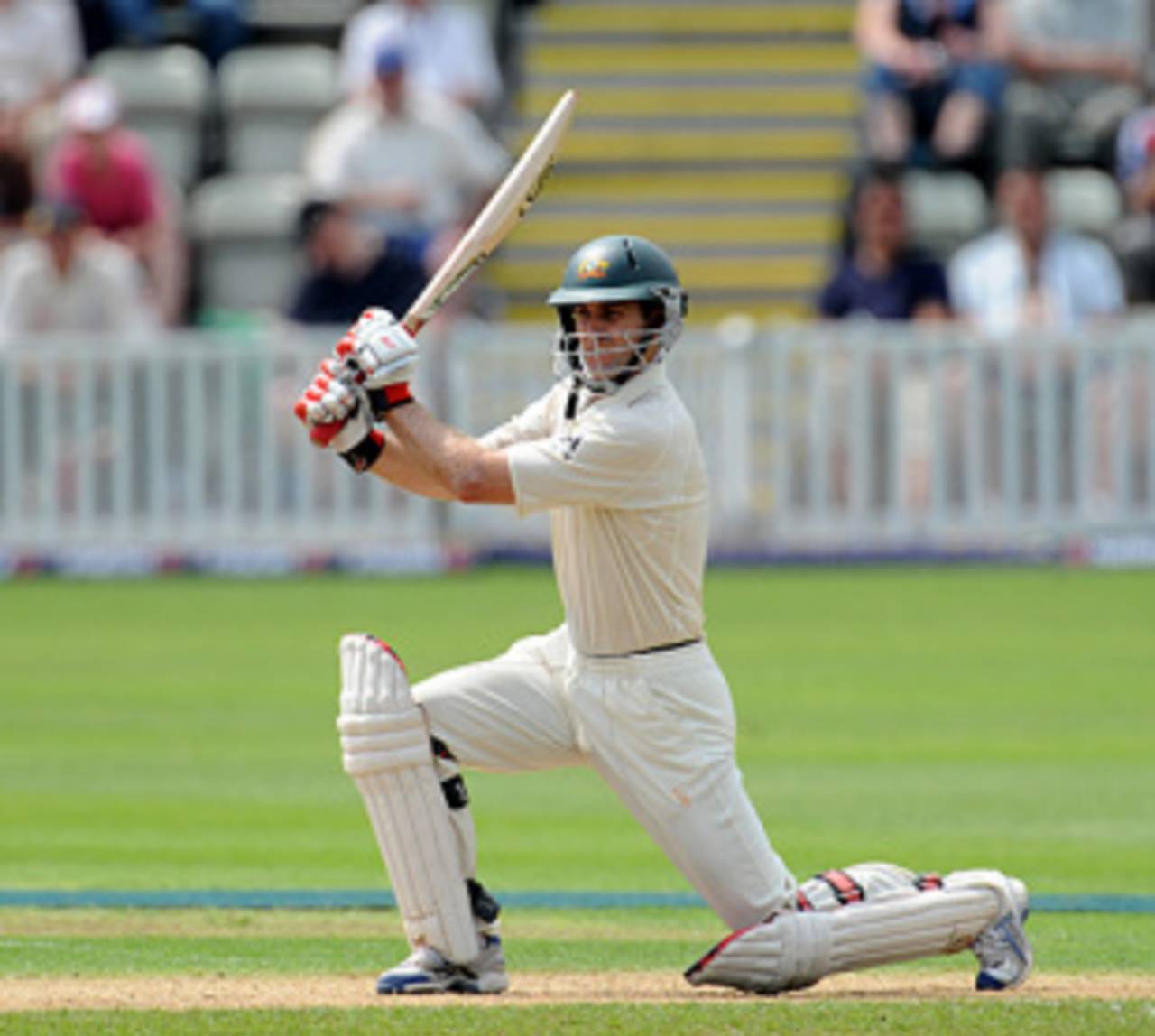Is top-order batting so difficult in England?
Traditional wisdom suggests facing the new ball is the most difficult proposition in England, but numbers from the last two decades indicate otherwise

Simon Katich had an excellent time on the second day in Cardiff as Australia's top three made merry • PA Photos
| Host country | 1st wkt | 2nd wkt | 3rd wkt | 4th wkt | 5th wkt | 6th wkt | 7th wkt |
| Australia | 41.43 | 47.00 | 43.84 | 51.43 | 39.66 | 37.28 | 27.59 |
| Bangladesh | 38.59 | 35.72 | 30.43 | 38.12 | 37.48 | 39.28 | 28.32 |
| England | 42.81 | 44.66 | 46.29 | 45.32 | 39.41 | 36.44 | 24.28 |
| India | 45.20 | 45.39 | 45.05 | 43.71 | 48.70 | 38.63 | 32.84 |
| New Zealand | 30.66 | 35.42 | 35.76 | 40.58 | 42.10 | 37.81 | 38.73 |
| Pakistan | 41.81 | 43.70 | 57.03 | 53.92 | 44.57 | 38.28 | 24.47 |
| South Africa | 38.08 | 39.53 | 46.52 | 37.29 | 33.22 | 31.90 | 28.72 |
| Sri Lanka | 38.41 | 35.53 | 49.40 | 40.70 | 35.62 | 36.47 | 27.00 |
| West Indies | 41.22 | 42.49 | 43.42 | 48.07 | 45.74 | 38.42 | 28.34 |
| Zimbabwe | 35.96 | 41.28 | 41.50 | 47.53 | 30.57 | 38.66 | 29.09 |
| Host country | Wkts 1-4: ave stand | 100/ 50 p'ships | Wkts 4-7: ave stand | 100/ 50 p'ships |
| India | 44.85 | 71/ 124 | 40.37 | 42/ 65 |
| New Zealand | 35.51 | 46/ 81 | 39.58 | 33/ 63 |
| West Indies | 43.75 | 85/ 112 | 37.76 | 39/ 72 |
| Pakistan | 48.94 | 60/ 95 | 36.02 | 24/ 40 |
| Bangladesh | 35.73 | 32/ 57 | 35.19 | 17/ 51 |
| Australia | 45.83 | 95/ 159 | 35.02 | 33/ 99 |
| England | 44.69 | 107/ 168 | 33.56 | 37/ 105 |
| Sri Lanka | 40.96 | 62/ 140 | 33.17 | 38/ 57 |
| Zimbabwe | 41.36 | 31/ 47 | 32.81 | 11/ 33 |
| South Africa | 40.40 | 70/ 128 | 31.34 | 24/ 71 |
| Pair | Innings | Runs | Average stand | 100/ 50 p'ships |
| Flintoff-Jones | 11 | 836 | 83.60 | 4/ 2 |
| Bell-Prior | 6 | 416 | 83.20 | 1/ 2 |
| Bravo-Chanderpaul | 10 | 805 | 80.50 | 2/ 6 |
| Collingwood-Pietersen | 7 | 505 | 72.14 | 2/ 3 |
| de Villiers-Prince | 5 | 338 | 67.60 | 1/ 1 |
| Gilchrist-Martyn | 5 | 301 | 60.20 | 1/ 1 |
| Bell-Collingwood | 13 | 537 | 48.81 | 2/ 1 |
| Flintoff-Thorpe | 7 | 339 | 48.42 | 0/ 4 |
| Host country | 1980s - Ave stand | 100/ 50 p'ships | 1990s - Ave stand | 100/ 50 p'ships |
| Australia | 38.13 | 34/ 75 | 36.95 | 30/ 79 |
| Bangladesh | - | - | 23.00 | 0/ 1 |
| England | 35.61 | 28/ 63 | 41.71 | 41/ 76 |
| India | 39.56 | 22/ 54 | 39.88 | 22/ 41 |
| New Zealand | 33.78 | 14/ 28 | 38.39 | 25/ 47 |
| Pakistan | 35.85 | 18/ 55 | 37.32 | 19/ 33 |
| South Africa | - | - | 28.34 | 9/ 42 |
| Sri Lanka | 25.51 | 2/ 10 | 38.27 | 17/ 33 |
| West Indies | 41.77 | 23/ 31 | 35.92 | 22/ 46 |
| Zimbabwe | - | - | 32.59 | 13/ 21 |
S Rajesh is stats editor of Cricinfo